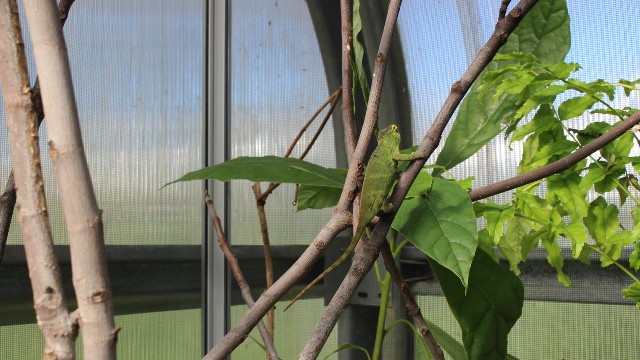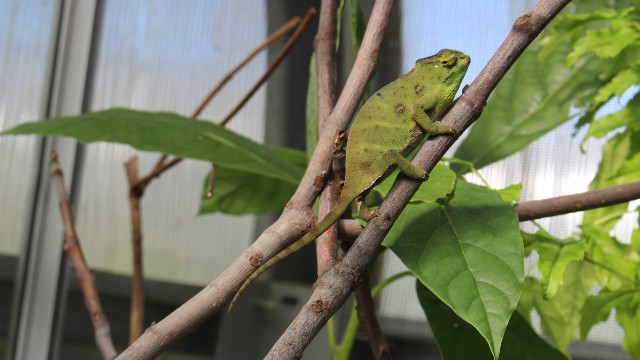CarlC
Established Member
Hey Everyone
Since my breeding is the topic I just captive hatched 14 Triocero wererni today!
Congrats Jeremy!
Carl
Follow along with the video below to see how to install our site as a web app on your home screen.
Note: This feature may not be available in some browsers.
Hey Everyone
Since my breeding is the topic I just captive hatched 14 Triocero wererni today!
Most excellent!
Congrats Jeremy!
Carl


Other than Calumma parsonii parsonii, here is another new Madagascar quota species that is living in my montane greenhouse. I am going to be picking up a male to pair with this female soon. Can you guess the species of this Madagascar chameleon? There is new Madagascar CITES quotas species!!!


Best Regards
Jeremy A. Rich
Very healthy looking female Furcifer willsii. I kept this species back in 2000/2001. I was particularly fond of the females.
BTW, the 2015 CITES quotas have been released: http://cites.org/sites/default/files/common/quotas/2015/ExportQuotas2015.pdf
Chris
all and all I do wish you and the rest who is working with this species successbut only if we get to see the pics of the future hatchlings

Very healthy looking female Furcifer willsii. I kept this species back in 2000/2001. I was particularly fond of the females.
BTW, the 2015 CITES quotas have been released: http://cites.org/sites/default/files/common/quotas/2015/ExportQuotas2015.pdf
Chris
Where were you living back in 2000/2001? Over sea's?
Best Regards
Jeremy A. Rich
I have known for a while and upon review that not all of the Non Threatened and Vulnerable species are on the Madagascar Chameleon quota list. I absolutely think not all the Non Threatened species should be on the CITES quota list and it should stay that way. There are several Non Threatened species and several Vulnerable species that won't be imported on the CITES quota list.
Jeremy as I'm sure you know commercial collection is illegal in most special designated areas of Madagascar. Since you didn't explain why the species you listed aren't or won't be collected I did for you.
Here is a list of Brookesia
Brookesia ambreensis- Near Threatened-Montagne d'Ambre National Park
Brookesia antakarana- Near Threatened-Montagne d'Ambre National Park
Brookesia brunoi- Near Threatened-Anja Reserve
Brookesia confidens- Near Threatened-Ankarana National Park
Brookesia micra- Near Threatened-Nosy Hara Marine National Park
Brookesia tuberculata- Vulnerable-Montagne d'Ambre National Park
Here is a list of the Furcifer
Furcifer angeli- Least Concern-Parc National d'Ankarafantsika, Parc National Baie de Baly, Parc National de Namoroka and Bongolava New Protected Area
Furcifer labordi- Vulnerable-Réserve Spéciale d'Andranomena, Parc National Mikea, Parc National Kirindy Mitea andas well as in two other protected areas that are currently under development (Antimena in the Menabe Region and PK32 Ranobe in the Atsimo Andrefana Region).
Furcifer rhinoceratus- Vulnerable-Parc National Ankarafantsika. More surveys are needed to confirm existence outside of park boundries.
Furcifer timoni- Near Threatened-Montagne d'Ambre National Park
Here is a list of Calumma
Calumma amber- Near Threatened-Montagne d'Ambre National Park
Calumma ambreense- Near Threatened-Montagne d'Ambre National Park
Calumma capuroni- Vulnerable-Parc National d'Andohahela
Calumma crypticum- Least Concern-
Calumma cucullatum- Vulnerable
Calumma guibei- Near Threatened-Réserve Naturelle Intégrale de Tsaratanana
Calumma jejy- Vulnerable-Parc National de Marojejy
Calumma peltierorum- Near Threatened-Réserve Naturelle Intégrale de Tsaratanana and Réserve Spéciale d'Anjanhajaribe-Sud
Calumma peyrierasi- Vulnerable-Marojejy National Park Calumma tsaratananense- Vulnerable Réserve Naturelle Intégrale de Tsaratanana
Calumma tsycorne- Vulnerable Réserve Spéciale Kalambatritra, Parc National d'Andohahela and Parc National Midongy
Carl
I have known for a while and upon review that not all of the Non Threatened and Vulnerable species are on the Madagascar Chameleon quota list. I absolutely think not all the Non Threatened species should be on the CITES quota list and it should stay that way. There are several Non Threatened species and several Vulnerable species that won't be imported on the CITES quota list.
Jeremy as I'm sure you know commercial collection is illegal in most special designated areas of Madagascar. Since you didn't explain why the species you listed aren't or won't be collected I did for you.
Here is a list of Brookesia
Brookesia ambreensis- Near Threatened-Montagne d'Ambre National Park
Brookesia antakarana- Near Threatened-Montagne d'Ambre National Park
Brookesia brunoi- Near Threatened-Anja Reserve
Brookesia confidens- Near Threatened-Ankarana National Park
Brookesia micra- Near Threatened-Nosy Hara Marine National Park
Brookesia tuberculata- Vulnerable-Montagne d'Ambre National Park
Here is a list of the Furcifer
Furcifer angeli- Least Concern-Parc National d'Ankarafantsika, Parc National Baie de Baly, Parc National de Namoroka and Bongolava New Protected Area
Furcifer labordi- Vulnerable-Réserve Spéciale d'Andranomena, Parc National Mikea, Parc National Kirindy Mitea andas well as in two other protected areas that are currently under development (Antimena in the Menabe Region and PK32 Ranobe in the Atsimo Andrefana Region).
Furcifer rhinoceratus- Vulnerable-Parc National Ankarafantsika. More surveys are needed to confirm existence outside of park boundries.
Furcifer timoni- Near Threatened-Montagne d'Ambre National Park
Here is a list of Calumma
Calumma amber- Near Threatened-Montagne d'Ambre National Park
Calumma ambreense- Near Threatened-Montagne d'Ambre National Park
Calumma capuroni- Vulnerable-Parc National d'Andohahela
Calumma crypticum- Least Concern-
Calumma cucullatum- Vulnerable
Calumma guibei- Near Threatened-Réserve Naturelle Intégrale de Tsaratanana
Calumma jejy- Vulnerable-Parc National de Marojejy
Calumma peltierorum- Near Threatened-Réserve Naturelle Intégrale de Tsaratanana and Réserve Spéciale d'Anjanhajaribe-Sud
Calumma peyrierasi- Vulnerable-Marojejy National Park Calumma tsaratananense- Vulnerable Réserve Naturelle Intégrale de Tsaratanana
Calumma tsycorne- Vulnerable Réserve Spéciale Kalambatritra, Parc National d'Andohahela and Parc National Midongy
Carl
To be collected and be qualified as a Vulnerable species or less threatened their range has to be much larger than just than one or two National Parks. Look at the google map on the IUCN Red List page for an accurate range size for these species. There is most probably more smaller preserves other than National Parks protecting these species as well.
Best Regards
Jeremy A. Rich
To be collected and be qualified as a Vulnerable species or less threatened their range has to be much larger than just than one or two National Parks. Look at the google map on the IUCN Red List page for an accurate range size for these species. There is most probably more smaller preserves other than National Parks protecting these species as well.
Best Regards
Jeremy A. Rich
Sorry, Jeremy, but from your list, Calumma amber, C. capuroni, C. cucullatum, C. guibei, C. jejy, C. peltierorum, C. peyrierasi, C. tsaratananense, C. tsycorne, Furcifer angeli, and F. labordi remain under the 1995 trade suspension pending recognition by CITES of compliance with paragraphs 2(a) and 3 of Article IV by Madagascar. Further, Brookesia ambreensis, B. antakarana, B. brunoi, B. confidens, B. micra, B. tuberculata, F. timoni, C. amber, C. ambreense, C. capuroni, C. guibei, C. jejy, C. peltierorum, C. peyrierasi and C. tsaratananense are not currently documented as occurring in sites from where collection is permitted. That leaves F. rhinoceratus and C. crypticum from your list, so most of those species are unlikely to get quotas until the suspension on them is lifted and/or occurrence outside of protected areas is confirmed.
Chris
Chris
You did not understand me then. I was stating that these species listed as Non Threatened or Vulnerable species are not listed as quota species. If there becomes a trend of new quota chameleon species (seems to be happening) I think for the most part that most of these Non Threatened and Vulnerable species should stay off the CITES quota list. As this gives Eco Tourist something to look forward too that is not in their living room and keeps wildlife areas wild and not totally on the Agricultural (pristine wild areas/exploitation ranched or collected wild areas) side of things.
Best Regards
Jeremy A. Rich
Jeremy,
You're right, I missed the "not" part. In either event, the above are reasons are why we will be unlikely to have those species added to a quota list, at least until a number of things change.
Chris